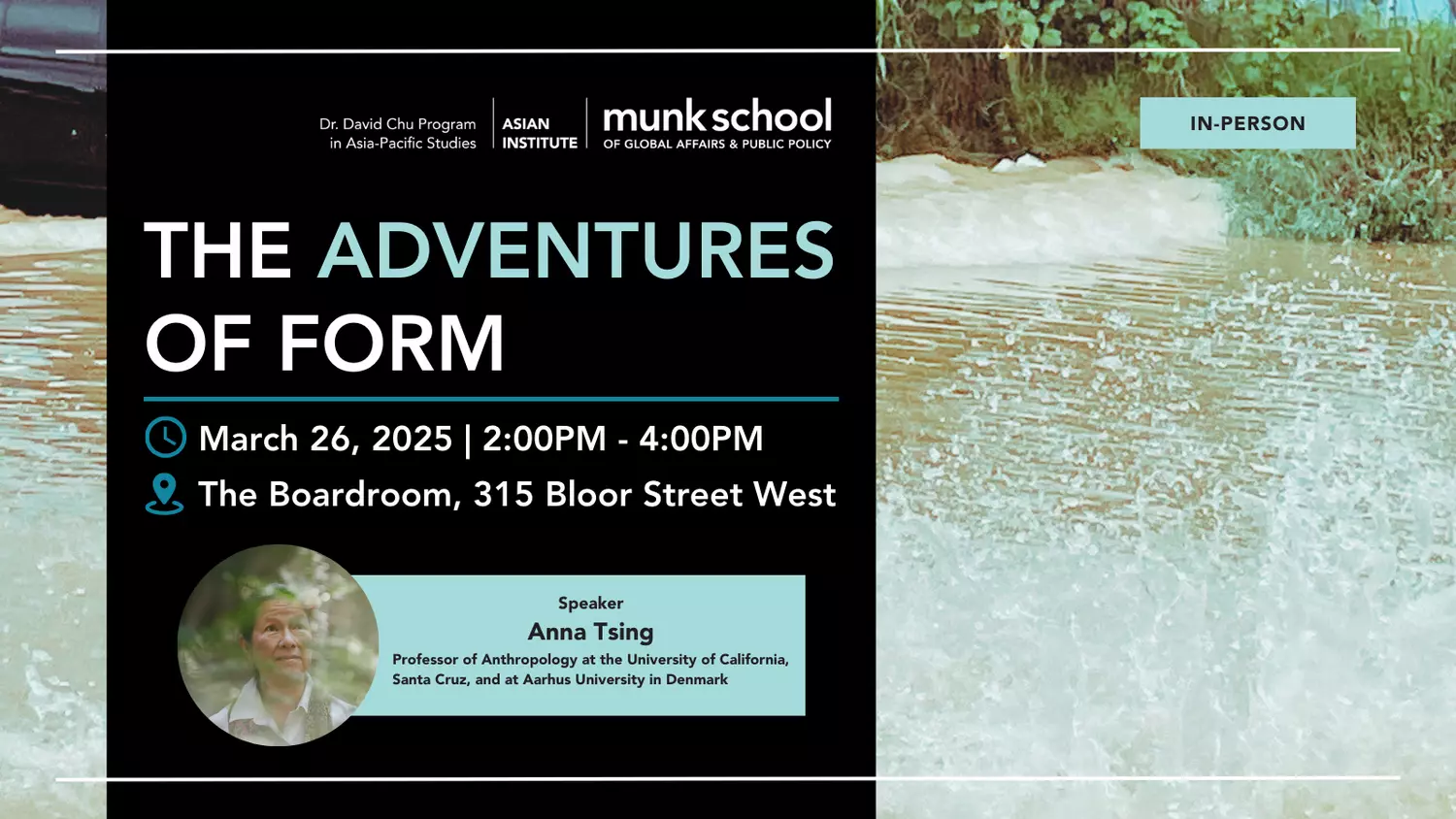On November 9, 2018, the lecture “Hou Hsiao-Hsien and Edward Yang: The Epistemological Stakes of Two Realisms in New Taiwan Cinema” was held at the Munk School of Global Affairs and Public Policy. Being part of the Global Taiwan Lecture Series, this e event was sponsored by the Global Taiwan Studies Program at the Munk School. At the beginning of the event, the moderator, Professor Tong Lam, from the Department of Historical Studies and the Graduate Department of History at the University of Toronto, warmly welcomed and introduced the speaker, Professor Jason McGrath. Professor McGrath is an Associate Professor of Asian Languages and Literatures at the University of Minnesota. He is currently working on the book project “Inscribing the Real: Realism and Convention in Chinese Cinema from the Silent Era to the Digital Age.” Professor McGrath presented on another ongoing project on New Taiwan cinema, and Hou Hsiao-Hsien’s films in particular. In the lecture, Professor McGrath analyzed various types of cinematic realism by comparing Hou Hsiao-Hsien’s films with Edward Yang’s Yi Yi and looking into some well-established cinematic theories.
Professor McGrath started his presentation by introducing the central concept of realism. Though admitting that the concept of realism is fundamentally dialectic and subjected to constant negotiations of conventions and confrontations of the real world, Professor McGrath clarified that it would still be useful to look into the different types of claims about cinematic realism. After briefly going through his analytical categories, including ontological realism, perceptual realism, fictional realism, verisimilar realism and prescriptive realism, Professor McGrath proposed his own claim of realism, apophatic realism, which is a cinematic aesthetic based on the idea that the real will always escape or exceed representation. Filmmakers around the world have demonstrated this belief that reality is fundamentally inaccessible in their films through different approaches. For example, some filmmakers might choose to leave out the most traumatic experience through ellipsis editing because they believe this part of the narrative is impossible to represent.
After a brief introduction to cinematic realism, Professor McGrath discussed apophatic realism with particular reference to Hou Hsiao-Hsien’s films. As a leading figure of the “New Taiwan cinema” which emerged in the 1980s and a widely-acknowledged master realist, Hou Hsiao-Hsien have attempted to represent Taiwan as what it really is rather than what it should be. By showing a video clip from Goodbye South, Goodbye, Professor McGrath analyzed Hou’s unique cinematic style that embodies long, static takes, which is often seen as a common feature of the category of Asian slow cinema. Professor McGrath humorously summarized such long takes as “last several minutes but not much happened, which sometimes bore people,” especially compared with intense Hollywood films. However, he argued that there is actually abundant information embedded in Hou’s slow-paced long takes. In order to expand his argument, Professor McGrath introduced Edward Yang’s Yi Yi as a comparison, and specifically focused on the ways that Edward Yang manages space and uses the screen as a metaphor. In Yi Yi, Edward Yang seems to show what the audience cannot see, as demonstrated in his use of shots from a security camera, the attempts of the little boy Yang Yang, to take pictures of the back of people’s heads, and the 360-degree shot of Yang Yang’s mother standing in front of a mirror. Professor McGrath pointed out that this kind of efforts in Yi Yi corresponds with Malcolm Turvey’s concept of the revelationist tradition in film theory, which argues that film can be a way to show us what we cannot see. To some extent, Edward Yang also sought to represent contemporary Taipei as a totality in Yi Yi, showing us how a typical middle-class family lived through social and economic transitions.
Professor McGrath argued that, compared with Edward Yang, Hou Hsiao-Hsien has taken a different approach to cinematic representation of the real by constantly enhancing the idea that one can only see one side of the reality at a time. Hou has used reflective surfaces in various films to obscure the real story. For example, in Goodbye South, Goodbye, Hou showed something that was blurry and black in the first shot, but when the camera focused it turned out to be the character Gao’s tattoo, and in the next cut one could figure out that it was Gao’s girlfriend looking at his tattoo through a glass. After showing a video clip from this movie, Professor McGrath encouraged the audience to discover evidence of Hou’s obscured reality. He later revealed his finding that in this sequence of shots, Gao’s tattoo seemed to have moved to a different shoulder, but actually by the end of the shot it turned out that the whole shot was taken through a mirror. By displaying screenshots and video clips from Hou’s films, Professor McGrath led the audience into a fascinating and inspiring world where one’s own perception is called into question but without explicit signalling. Professor McGrath brought up the use of occlusion as another striking feature of Hou’s films. While many filmmakers, such as Ang Lee, have tried to ensure maximum visual access to everyone when there are multiple characters in a single shot, Hou Hsiao-Hsien does not seem to care about figural clarity. For instance, in dozens of shots in A City of Sadness and Flowers of Shanghai, characters often obscure each other or are obscured by certain objects. Hou consistently leaves the most important parts of the narrative out of the frame. Typical examples here are fight scenes in Hou’s films. Generally speaking, fight scenes present the highlight of the story and require the most visual coherence. In one of the violent scene in Yi Yi, Edward Yang constantly moved the camera to capture high-drama moments in the frame. On the contrary, Hou Hsiao-Hsien has consistently use occlusion to intentionally leave out the most dramatic content. Professor McGrath showed examples from The Boys from Fengkuei, City of Sadness and The Assassins to demonstrate the seemingly “perverse” things that Hou have done to his audience. In these cases, when actions spill out the screen, Hou’s camera refuses to move. Instead of cutting into a closer shot, Hou sometimes even takes a more distant shot, which prevents the audience from accessing what is going on. While watching the video clips, there were a few chuckles among the audience, and the audiences was amused by Hou’s “perverse” photographic style.
Professor McGrath concluded that the aforementioned techniques, including the use of ellipsis, reflective surfaces, occlusion and off-screen space, have all contributed to Hou Hsiao Hsien’s unique cinematic aesthetic, which aims to foreground one’s lack of access to the real world stories. As this lecture approached the end, Professor McGrath presented one of his favourite film endings from Hou’s Goodbye South, Goodbye. It was an extremely long shot at dawn. All protagonists of this film were in a moving car and they drove all night. The car suddenly drove off the road to a fieldfor an . Peoples’ voices, initially distant, reached a crescendo. According to Professor McGrath, the lack of closure in Hou’s films is a philosophical metaphor for the lack of truth or certainty. Departing from the case of Hou Hsiao-Hsien, Professor McGrath finally looked into broader frameworks of world cinema and philosophy by quoting scholars and critics such as V.F. Perkins and André Bazin. While the audience tries to construct t the idea of a coherent world by watching the film, Hou Hsiao-Hsien always questions such knowledge, calling our attention to the fundamental unknowability of reality, and makes us aware of our own doubts about the world.
The lecture was followed by a 50-minute Q&A session, during which Professor McGrath and members of the audience had heated discussions on models of realism in Hou Hsiao-Hsien’s films. Regarding the fight scenes, a member of the audience raised the interesting point that by using ambiguity, Hou actually makes high-dramatic content more real. In response, Professor McGrath mentioned that the use of occlusion and off-screen space is also an effective technique to distance the audience from the emotional and historical content. Adding to this conversation, another audience member pointed out that City of Sadness is based on the 2.28 Incident in Taiwan.
Jeeby Sun is an event reporter for Synergy: The Journal of Contemporary Asian Studies, East Asia section.








